Analysis of the Dynamic System Driving High-Quality Transformation of Resource-Based Regions Through Smart Eco-Innovation: Evidence from Daqing City, China
Abstract
1. Introduction
2. Materials and Methods
2.1. System Dynamics Modeling (SDM)
2.2. System Design
2.3. System Structural Relationships and Variable Setting
2.3.1. Causal Relationship
2.3.2. Flow Diagrams
2.3.3. Setting of Input and Output Variables
3. Simulation Result Analysis
3.1. Selection of Study Region
3.2. Data Sources and Processing
3.3. Parameter Setting and Validation
3.4. Simulation Scenario Design
3.5. Result
4. Discussion
5. Conclusions and Implications
5.1. Conclusions
5.2. Implications
6. Limitations and Future Recommendations
Author Contributions
Funding
Institutional Review Board Statement
Informed Consent Statement
Data Availability Statement
Conflicts of Interest
Abbreviations
| eco-innovation | Ecological innovation |
| IT | Information technology |
| ICT | Information and communication technology |
| AI | Artificial intelligence |
| SDM | System dynamics modeling |
| tce | Ton of standard coal equivalent |
| three wastes | Waste water, waste gas, solid waste |
Appendix A
| Primary Indicator | Secondary Indicator | Unit | Indicator Attribute | Secondary Indicator | Unit | Indicator Attribute |
|---|---|---|---|---|---|---|
| Scientific and technological innovation subsystem | Science and technology human resources (number of R&D personnel) | ten thousand people | state variable | R&D investment | hundred million yuan | auxiliary variable |
| Increase in science and technology human resources | ten thousand people | rate variable | Education investment | hundred million yuan | auxiliary variable | |
| Decrease in science and technology human resources | ten thousand people | rate variable | R&D investment coefficient | / | constant | |
| Number of postgraduate graduates | people | auxiliary variable | Education investment coefficient | / | constant | |
| Science and technology resource investment | hundred million yuan | auxiliary variable | Number of patent applications | piece | auxiliary variable | |
| Science and technology resource investment coefficient | / | constant | ||||
| Economic coordination subsystem | GDP | hundred million yuan | state variable | Smart agriculture investment | hundred million yuan | auxiliary variable |
| GDP increase | hundred million yuan | rate variable | Smart agriculture investment coefficient | / | constant | |
| GDP growth rate | % | auxiliary variable | Value added of the primary industry | hundred million yuan | auxiliary variable | |
| Fiscal expenditure | hundred million yuan | auxiliary variable | Value added of the secondary industry | hundred million yuan | auxiliary variable | |
| Fiscal expenditure coefficient | / | constant | Value added of industry | hundred million yuan | auxiliary variable | |
| Fixed asset investment | hundred million yuan | auxiliary variable | Value added of the tertiary industry | hundred million yuan | auxiliary variable | |
| Fixed asset investment coefficient | / | constant | Energy consumption of the primary industry value added | ten thousand tce | auxiliary variable | |
| Investment in the primary industry | hundred million yuan | auxiliary variable | Energy consumption of the secondary industry value added | ten thousand tce | auxiliary variable | |
| Investment in the secondary industry | hundred million yuan | auxiliary variable | Energy consumption of the tertiary industry value added | ten thousand tce | auxiliary variable | |
| Investment in the tertiary industry | hundred million yuan | auxiliary variable | Energy consumption coefficient for value added of the three industries | / | constant | |
| Investment coefficient of the three industries | / | constant | Industrial coordination | / | state variable | |
| Smart city investment | hundred million yuan | auxiliary variable | Industrial coordination change rate | % | rate variable | |
| Smart city investment coefficient | / | constant | Urban–rural coordination | / | state variable | |
| Smart energy investment | hundred million yuan | auxiliary variable | Urban–rural coordination change rate | % | rate variable | |
| Smart energy investment coefficient | / | constant | ||||
| Green energy subsystem | Remaining available energy reserves | ten thousand tce | state variable | Production of the three wastes | ten thousand tons | auxiliary variable |
| Energy production | ten thousand tce | rate variable | Non-compliant amount of the three wastes | ten thousand tons | auxiliary variable | |
| Energy consumption | ten thousand tce | rate variable | Compliance rate of the three wastes | % | auxiliary variable | |
| Sectoral energy consumption | ten thousand tce | auxiliary variable | Economic loss due to pollution | hundred million yuan | auxiliary variable | |
| Industrial energy consumption | ten thousand tce | auxiliary variable | Environmental capacity | / | state variable | |
| Residential energy consumption | ten thousand tce | auxiliary variable | Rate of change in environmental capacity | % | rate variable | |
| Smart energy investment | hundred million yuan | auxiliary variable | Environmental pollution carrying capacity | / | auxiliary variable | |
| Smart energy investment coefficient | / | constant | Smart environmental protection investment | hundred million yuan | state variable | |
| Economic loss due to energy shortage | hundred million yuan | auxiliary variable | Annual smart environmental protection investment | hundred million yuan | rate variable | |
| Existing pollution quantity | ten thousand tons | state variable | Smart environmental protection investment coefficient | / | constant | |
| Increase in pollutant quantity | ten thousand tons | rate variable | ||||
| Open development subsystem | Regional openness | / | state variable | Total commodity flow value | hundred million yuan | auxiliary variable |
| Change in regional openness | / | rate variable | Commodity import and export value | hundred million dollars | auxiliary variable | |
| Total capital inflow | hundred million yuan | auxiliary variable | Domestic commodity flow value | hundred million yuan | auxiliary variable | |
| Actual foreign capital utilized | hundred million dollars | auxiliary variable | Smart business environment construction | hundred million yuan | auxiliary variable | |
| Actual domestic capital utilized | hundred million yuan | auxiliary variable | Smart business environment construction coefficient | / | constant | |
| People’s livelihood subsystem | Total population | ten thousand people | state variable | Population outflow volume | ten thousand people | auxiliary variable |
| Net population growth | ten thousand people | rate variable | Environmental pollution coefficient | / | auxiliary variable | |
| Volume of growth of natural population | ten thousand people | auxiliary variable | Living standard (per capita GDP) | ten thousand yuan | auxiliary variable | |
| Net population inflow volume | ten thousand people | auxiliary variable | Smart livelihood construction | hundred million yuan | auxiliary variable | |
| Population inflow volume | ten thousand people | auxiliary variable | Smart livelihood construction coefficient | / | constant | |
| Terms | Meaning |
|---|---|
| Smart ecology construction: | Achieving urban sustainability by promoting harmonious coexistence between humans and nature, optimizing resource utilization, reducing pollution emissions, and enhancing residents’ quality of life through technological innovation and urban planning. |
| High-quality development: | Development driven by innovation, characterized by coordination, embodied in green practices, pursued through openness, and aimed at sharing, seeks to transform economic growth from mere scale expansion to quality and efficiency enhancement, thereby fulfilling people’s aspirations for a better life and achieving comprehensive and sustainable development. |
| New development concept: | A scientific conceptual framework primarily comprising innovation, coordination, green development, openness, and sharing, guiding economic and social development to promote high-quality growth, facilitate comprehensive progress, and achieve sustainability. |
| Oil-to-chemicals: | A development model that uses petroleum as raw material, extends the industrial chain, and enhances product value added through deep processing in the petrochemical industry, thereby transforming a resource-based economy towards diversification and high-end development. |
| Urban resilience: | The capacity of an urban system to withstand, adapt to, and rapidly recover from natural disasters, socio-economic shocks, or other uncertainties, while learning from crises to enhance its own sustainable development. |
References
- Bakıcı, T.; Almirall, E.; Wareham, J. A smart city initiative: The case of Barcelona. J. Knowl. Econ. 2013, 4, 135–148. [Google Scholar] [CrossRef]
- Bibri, S.E.; Krogstie, J.; Kaboli, A.; Alahi, A. Smarter eco-cities and their leading-edge artificial intelligence of things solutions for environmental sustainability: A comprehensive systematic review. Environ. Sci. Ecotechnol. 2024, 19, 100330. [Google Scholar] [CrossRef] [PubMed]
- Li, H.; Dong, L.; Ren, J. Industrial symbiosis as a countermeasure for resource dependent city: A case study of Guiyang, China. J. Clean. Prod. 2015, 107, 252–266. [Google Scholar] [CrossRef]
- An, K.; Wang, C.; Cai, W. Low-carbon technology diffusion and economic growth of China: An evolutionary general equilibrium framework. Struct. Change Econ. Dyn. 2023, 65, 253–263. [Google Scholar]
- Dornhöfer, M.; Weber, C.; Zenkert, J.; Fathi, M. A data-driven smart city transformation model utilizing the green knowledge management cube. In Proceedings of the 2019 IEEE International Smart Cities Conference (ISC2), Casablanca, Morocco, 14–17 October 2019; IEEE: Piscataway, NJ, USA, 2019; pp. 691–696. [Google Scholar]
- Mishra, R.K.; Kumari, C.L.; Janaki Krishna, P.S.; Dubey, A. Smart cities for sustainable development: An overview. In Smart Cities for Sustainable Development; Springer: Singapore, 2022; pp. 1–12. [Google Scholar]
- Sutherland, M.K.; Cook, M.E. Data-Driven Smart cities: A closer look at organizational, technical and data complexities. In Proceedings of the 18th Annual International Conference on Digital Government Research, Staten Island, NY, USA, 7–9 June 2017; pp. 471–476. [Google Scholar]
- Visvizi, A.; del Hoyo, R.P. (Eds.) Smart Cities and the UN SDGs; Elsevier: Amsterdam, The Netherlands, 2021. [Google Scholar] [CrossRef]
- Xu, Y.; Li, W.; Tai, J.; Zhang, C. A Bibliometric-Based Analytical Framework for the Study of Smart City Lifeforms in China. Int. J. Environ. Res. Public Health 2022, 19, 14762. [Google Scholar] [CrossRef]
- Battarra, R.; Gargiulo, C.; Zucaro, F. Future possibility of smart and sustainable cities in the Mediterranean basin. J. Urban Plan. Dev. 2020, 146, 04020036. [Google Scholar] [CrossRef]
- Guo, Q.; Wang, Y.; Dong, X. Effects of smart city construction on energy saving and CO2 emission reduction: Evidence from China. Appl. Energy 2022, 313, 118879. [Google Scholar] [CrossRef]
- Bibri, S.E. Data-driven smart sustainable cities of the future: New conceptions of and approaches to the spatial scaling of urban form. Future Cities Environ. 2021, 7, 1–15. [Google Scholar] [CrossRef]
- Vandergert, P.; Sandland, S.; Newport, D.; Van Den Abeele, P. Harnessing Advances in Eco-Innovation to Achieve Resource Efficient Cities. Green Design, Materials and Manufacturing Processes; Taylor and Francis Group: London, UK, 2013. [Google Scholar]
- Naphade, M.; Banavar, G.; Harrison, C.; Paraszczak, J.; Morris, R. Smarter cities and their innovation challenges. Computer 2011, 44, 32–39. [Google Scholar] [CrossRef]
- Bradbury, J.H. Towards an alternative theory of resource-based town development in Canada. Econ. Geogr. 1979, 55, 147–166. [Google Scholar] [CrossRef]
- Bradbury, J.H.; St-Martin, I. Winding down in a Quebec mining town: A case study of Schefferville. Can. Geogr./Géogr. Can. 1983, 27, 128–144. [Google Scholar]
- Sachs, J.D.; Warner, A.M. The curse of natural resources. Eur. Econ. Rev. 2001, 45, 827–838. [Google Scholar]
- Destek, M.A.; Aydın, S.; Destek, G. Investigating an optimal resource dependency to prevent natural resource curse: Evidence from countries with the curse risk. Resour. Policy 2022, 79, 102981. [Google Scholar] [CrossRef]
- Keller, M. Oil revenues vs domestic taxation: Deeper insights into the crowding-out effect. Resour. Policy 2022, 76, 102560. [Google Scholar] [CrossRef]
- Zheng, F.; Niu, Y. Environmental decentralization, resource endowment and urban industrial transformation and upgrading: A comparison of resource-based and non-resource-based cities in China. Sustainability 2023, 15, 10475. [Google Scholar] [CrossRef]
- Wang, X.; Liu, H.; Chen, Z. Transformation of resource-based cities: The case of Benxi. Front. Environ. Sci. 2022, 10, 903178. [Google Scholar] [CrossRef]
- Mitchell, C.J.; O’Neill, K. Tracing economic transition in the mine towns of northern Ontario: An application of the “resource-dependency model”. Can. Geogr./Géogr. Can. 2016, 60, 91–106. [Google Scholar]
- Douglas, S.; Walker, A. Coal mining and the resource curse in the eastern United States. J. Reg. Sci. 2017, 57, 568–590. [Google Scholar]
- Martinus, K. Regional development in a resource production system: Long distance commuting, population growth, and wealth redistribution in the Western Australia Goldfields. Geogr. Res. 2016, 54, 420–432. [Google Scholar]
- Ma, Y.; Yan, J.; Sha, J.; He, G.; Song, C.; Fan, S.; Ke, W. Dynamic simulation of the atmospheric environment improved by a focus on clean energy utilization of resource-based cities in China. J. Clean. Prod. 2018, 192, 396–410. [Google Scholar] [CrossRef]
- Yang, Y.; Guo, H.; Chen, L.; Liu, X.; Gu, M.; Ke, X. Regional analysis of the green development level differences in Chinese mineral resource-based cities. Resour. Policy 2019, 61, 261–272. [Google Scholar]
- Louw, H.; Marais, L. Mining and municipal finance in Kathu, an open mining town in South Africa. Extr. Ind. Soc. 2018, 5, 278–283. [Google Scholar]
- Cała, M.; Szewczyk-Świątek, A.; Ostręga, A. Challenges of coal mining regions and municipalities in the face of energy transition. Energies 2021, 14, 6674. [Google Scholar] [CrossRef]
- Kaczmarek, J.; Kolegowicz, K.; Szymla, W. Restructuring of the coal mining industry and the challenges of energy transition in Poland (1990–2020). Energies 2022, 15, 3518. [Google Scholar] [CrossRef]
- Kim, D.H.; Lin, S.C. Natural resources and economic development: New panel evidence. Environ. Resour. Econ. 2017, 66, 363–391. [Google Scholar]
- Yuan, T.; Xiang, Y.; Xiong, L. Driving forces and obstacles analysis of urban high-quality development in Chengdu. Sci. Rep. 2024, 14, 24530. [Google Scholar]
- Ma, X.; Xu, J. Impact of environmental regulation on high-quality economic development. Front. Environ. Sci. 2022, 10, 896892. [Google Scholar]
- Shen, L.; He, G. Threshold Effect of Financial System on High-Quality Economic Development. J. Math. 2022, 2022, 9108130. [Google Scholar]
- Luo, C.; Wei, D.; Su, W.; Lu, J. Association between regional digitalization and high-quality economic development. Sustainability 2023, 15, 1909. [Google Scholar] [CrossRef]
- Tan, J. Regional economic resilience of resource-based cities and influential factors during economic crises in China. In Economic Resilience in Regions and Organisations; Springer: Wiesbaden, Germany, 2021; pp. 91–115. [Google Scholar]
- Wang, D.; Shi, Y.; Wan, K. Integrated evaluation of the carrying capacities of mineral resource-based cities considering synergy between subsystems. Ecol. Indic. 2020, 108, 105701. [Google Scholar]
- Yan, D.; Kong, Y.; Ren, X.; Shi, Y.; Chiang, S. The determinants of urban sustainability in Chinese resource-based cities: A panel quantile regression approach. Sci. Total Environ. 2019, 686, 1210–1219. [Google Scholar] [PubMed]
- Ruan, F.; Yan, L.; Wang, D. The complexity for the resource-based cities in China on creating sustainable development. Cities 2020, 97, 102571. [Google Scholar]
- Dempsey, N.; Bramley, G.; Power, S.; Brown, C. The social dimension of sustainable development: Defining urban social sustainability. Sustain. Dev. 2011, 19, 289–300. [Google Scholar]
- While, A.; Jonas, A.E.; Gibbs, D. From sustainable development to carbon control: Eco-state restructuring and the politics of urban and regional development. Trans. Inst. Br. Geogr. 2010, 35, 76–93. [Google Scholar]
- World Economic Forum. Circular Economy in Cities. Evolving the Model for a Sustainable Urban Future; White Paper; World Economic Forum: Cologny, Switzerland, 2018. [Google Scholar]
- Zhou, J.; Xu, W.; Yan, D. Breaking the resource curse: The impact of digital economy on the sustainable transformation of resource-based cities. Sustain. Cities Soc. 2024, 113, 105707. [Google Scholar]
- Qiao, R.; Chen, W.; Qiao, Y. Sustainable development path of resource-based cities—Taking datong as an example. Sustainability 2022, 14, 14474. [Google Scholar] [CrossRef]
- Ab Rahman, A.; Hamid, U.Z.A.; Chin, T.A. Emerging technologies with disruptive effects: A review. PERINTIS eJournal 2017, 7, 111–128. [Google Scholar]
- Bibri, S.E.; Alexandre, A.; Sharifi, A.; Krogstie, J. Environmentally sustainable smart cities and their converging AI, IoT, and big data technologies and solutions: An integrated approach to an extensive literature review. Energy Inform. 2023, 6, 9. [Google Scholar]
- Forrester, J.W. Industrial dynamics: A major breakthrough for decision makers. In The Roots of Logistics; Springer: Berlin/Heidelberg, Germany, 2012; pp. 141–172. [Google Scholar]
- Davies, E.G.; Simonovic, S.P. Global water resources modeling with an integrated model of the social–economic–environmental system. Adv. Water Resour. 2011, 34, 684–700. [Google Scholar]
- Jiang, L.; Niu, H.; Ru, Y.; Tong, A.; Wang, Y. Can carbon finance promote high quality economic development: Evidence from China. Heliyon 2023, 9, e22698. [Google Scholar]
- Wang, X.; Dong, F.; Pan, Y.; Liu, Y. Transport infrastructure, high-quality development and industrial pollution: Fresh evidence from China. Int. J. Environ. Res. Public Health 2022, 19, 9494. [Google Scholar] [CrossRef] [PubMed]
- Xia, K.; Guo, J.K.; Han, Z.L.; Dong, M.R.; Xu, Y. Analysis of the scientific and technological innovation efficiency and regional differences of the land–sea coordination in China’s coastal areas. Ocean Coast. Manag. 2019, 172, 157–165. [Google Scholar]
- Yang, B.; Long, Y.; Yang, T.; Sun, W.; Shao, C. The Influence of the Flow of Scientific and Technological Factors on the High-Quality Development of Regional Economy. Sustainability 2024, 16, 9733. [Google Scholar] [CrossRef]
- Jiang, J.; Li, Y.; Li, Y.; Li, C.; Yu, L.; Li, L. Smart transportation systems using learning method for urban mobility and management in modern cities. Sustain. Cities Soc. 2024, 108, 105428. [Google Scholar]
- Alsamhi, S.H.; Afghah, F.; Sahal, R.; Hawbani, A.; Al-qaness, M.A.; Lee, B.; Guizani, M. Green internet of things using UAVs in B5G networks: A review of applications and strategies. Ad Hoc Netw. 2021, 117, 102505. [Google Scholar]
- Zhan, J.; Dong, S.; Hu, W. IoE-supported smart logistics network communication with optimization and security. Sustain. Energy Technol. Assess. 2022, 52, 102052. [Google Scholar]
- Cong, H.; Zou, D. The research on the mechanism and spatial–temporal differentiation of the coupling coordination development based on industrial cluster agglomeration. Clust. Comput. 2017, 20, 195–213. [Google Scholar]
- Adom, P.K.; Amuakwa-Mensah, F.; Agradi, M.P.; Nsabimana, A. Energy poverty, development outcomes, and transition to green energy. Renew. Energy 2021, 178, 1337–1352. [Google Scholar]
- Androniceanu, A.; Sabie, O.M. Overview of green energy as a real strategic option for sustainable development. Energies 2022, 15, 8573. [Google Scholar] [CrossRef]
- Cheng, P.; Wang, X.; Choi, B.; Huan, X. Green finance, international technology spillover and green technology innovation: A new perspective of regional innovation capability. Sustainability 2023, 15, 1112. [Google Scholar] [CrossRef]
- Ahad, M.A.; Paiva, S.; Tripathi, G.; Feroz, N. Enabling technologies and sustainable smart cities. Sustain. Cities Soc. 2020, 61, 102301. [Google Scholar]
- Chen, C.W. Can smart cities bring happiness to promote sustainable development? Contexts and clues of subjective well-being and urban livability. Dev. Built Environ. 2023, 13, 100108. [Google Scholar]
- Chen, Z.; Peng, W.; Yao, X. A Deep Neural Network-Based Intelligent Forecasting Approach for Multi-Dimensional Economic Indexes in Smart Cities. J. Circuits Syst. Comput. 2024, 33, 2450191. [Google Scholar]
- Li, X.; Zhuang, X. Eco-city problems: Industry–city–ecology, urbanization development assessment in resource-exhausted cities. Sustainability 2022, 15, 166. [Google Scholar] [CrossRef]
- Tang, J. How the Smart Energy Can Contribute towards Achieving the Sustainable Development Goal 7. Sustainability 2024, 16, 7822. [Google Scholar] [CrossRef]
- Tang, J.; Zhao, P.; Gao, Y. Can smart energy alleviate energy poverty in China?–Empirical evidence using synthetic control methods. J. Clean. Prod. 2024, 449, 141821. [Google Scholar]
- Jiang, Y.; Sun, J. Does smart city construction promote urban green development? Evidence from a double machine learning model. J. Environ. Manag. 2025, 373, 123701. [Google Scholar]
- Wu, J.; Lin, K.; Sun, J. The impact of smart city construction on urban energy efficiency: Evidence from China. Environ. Dev. Sustain. 2024, 1–24. [Google Scholar] [CrossRef]
- Li, Z.; Liang, Y.; Liao, Q.; Wang, B.; Huang, L.; Zheng, J.; Zhang, H. Review on intelligent pipeline technologies: A life cycle perspective. Comput. Chem. Eng. 2023, 175, 108283. [Google Scholar]
- Huang, Z.; Ge, S.; He, Y.; Wang, D.; Zhang, S. Research on the Intelligent System Architecture and Control Strategy of Mining Robot Crowds. Energies 2024, 17, 1834. [Google Scholar] [CrossRef]
- Liu, Y.; Yu, W.; Gao, C.; Chen, M. An auto-extraction framework for cep rules based on the two-layer lstm attention mechanism: A case study on city air pollution forecasting. Energies 2022, 15, 5892. [Google Scholar] [CrossRef]
- National Plan for the Sustainable Development of Resource-Based Cities (2013–2020). Available online: https://www.gov.cn/zfwj/2013-12/03/content_2540070.htm (accessed on 30 January 2025).
- Uehara, T.; Cordier, M.; Hamaide, B. Fully dynamic input-output/system dynamics modeling for ecological-economic system analysis. Sustainability 2018, 10, 1765. [Google Scholar] [CrossRef]
- Datola, G.; Bottero, M.; De Angelis, E.; Romagnoli, F. Operationalising resilience: A methodological framework for assessing urban resilience through System Dynamics Model. Ecol. Model. 2022, 465, 109851. [Google Scholar] [CrossRef]
- Zhao, C.; Zhu, Z.; Wang, Y.; Du, J. The Impact of Industrial Robots on Green Total Factor Energy Efficiency: Empirical Evidence from Chinese Cities. Energies 2024, 17, 5034. [Google Scholar] [CrossRef]
- Wang, Z.; Hao, Y. Can smart cities improve energy resilience? Evidence from 229 cities in China. Sustain. Cities Soc. 2024, 117, 105971. [Google Scholar] [CrossRef]
- Chen, P. Urban planning policy and clean energy development Harmony-evidence from smart city pilot policy in China. Renew. Energy 2023, 210, 251–257. [Google Scholar] [CrossRef]
- Zhao, Y.; Yang, Y.; Leszek, S.; Wang, X. Experience in the transformation process of “coal city” to “beautiful city”: Taking Jiaozuo City as an example. Energy Policy 2021, 150, 112164. [Google Scholar] [CrossRef]
- Höffken, J.I.; Limmer, A. Smart and eco-cities in India and China. In Smart and Sustainable Cities? Routledge: London, UK, 2020; pp. 90–105. [Google Scholar]
- Jaroń, A.; Borucka, A.; Deliś, P.; Sekrecka, A. An assessment of the possibility of using unmanned aerial vehicles to identify and map air pollution from infrastructure emissions. Energies 2024, 17, 577. [Google Scholar] [CrossRef]
- Chen, Z. Application of environmental ecological strategy in smart city space architecture planning. Environ. Technol. Innov. 2021, 23, 101684. [Google Scholar] [CrossRef]
- Yue, J.P.; Zhang, F.Q. Evaluation of industrial green transformation in the process of urbanization: Regional difference analysis in China. Sustainability 2022, 14, 4280. [Google Scholar] [CrossRef]
- Vohra, K.; Marais, E.A.; Bloss, W.J.; Schwartz, J.; Mickley, L.J.; Van Damme, M.; Clarisse, L.; Coheur, P.F. Rapid rise in premature mortality due to anthropogenic air pollution in fast-growing tropical cities from 2005 to 2018. Sci. Adv. 2022, 8, 4435. [Google Scholar]
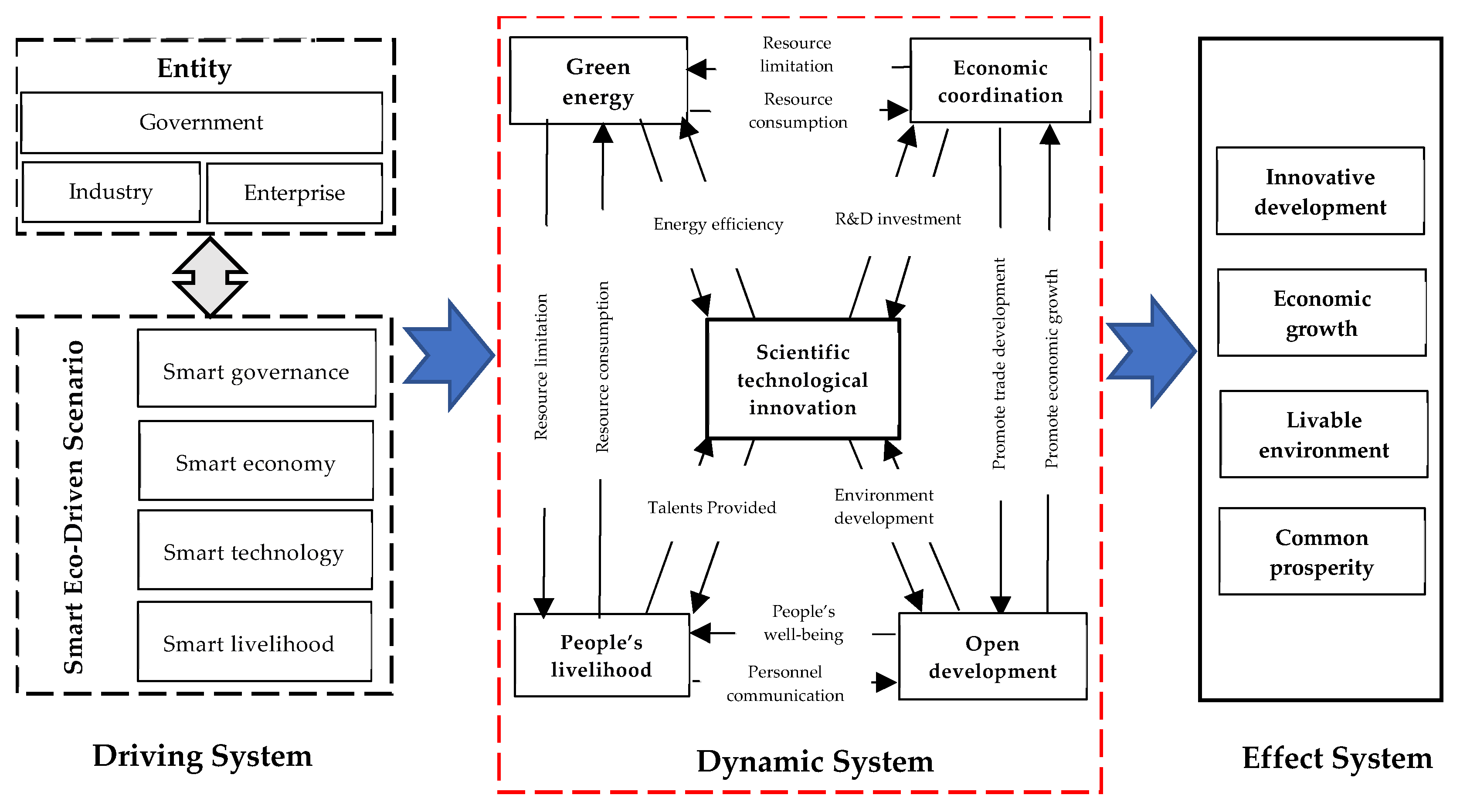
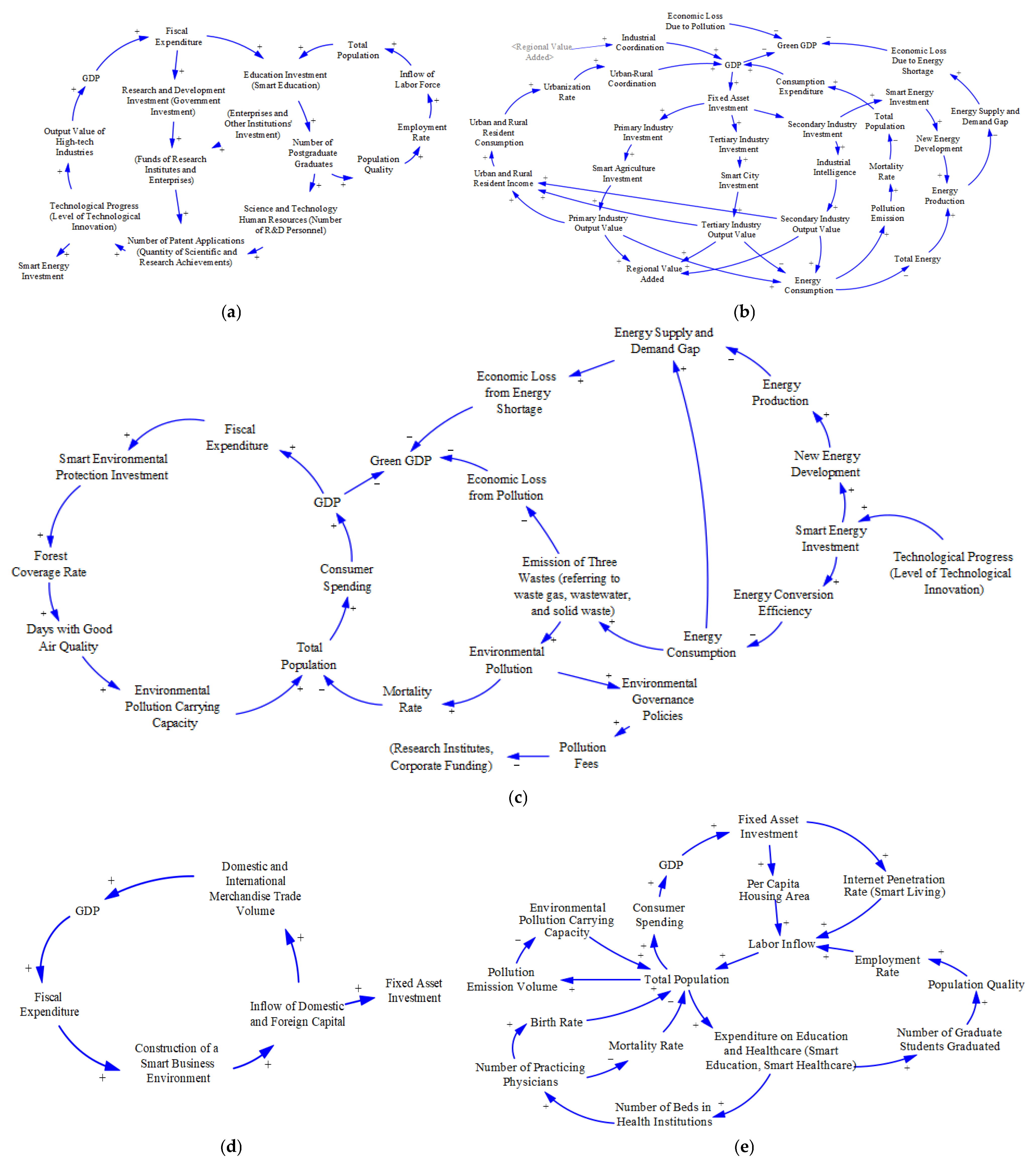

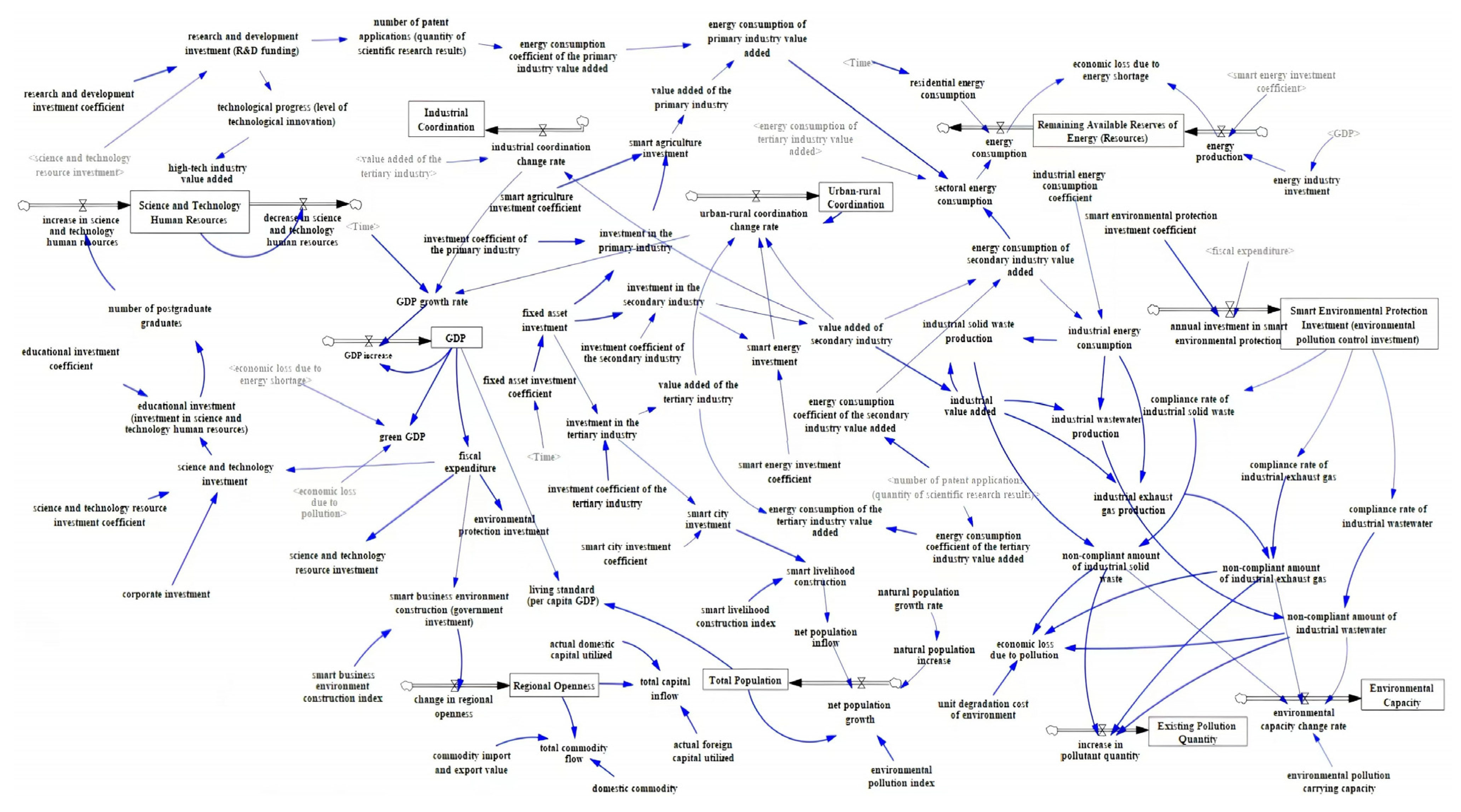
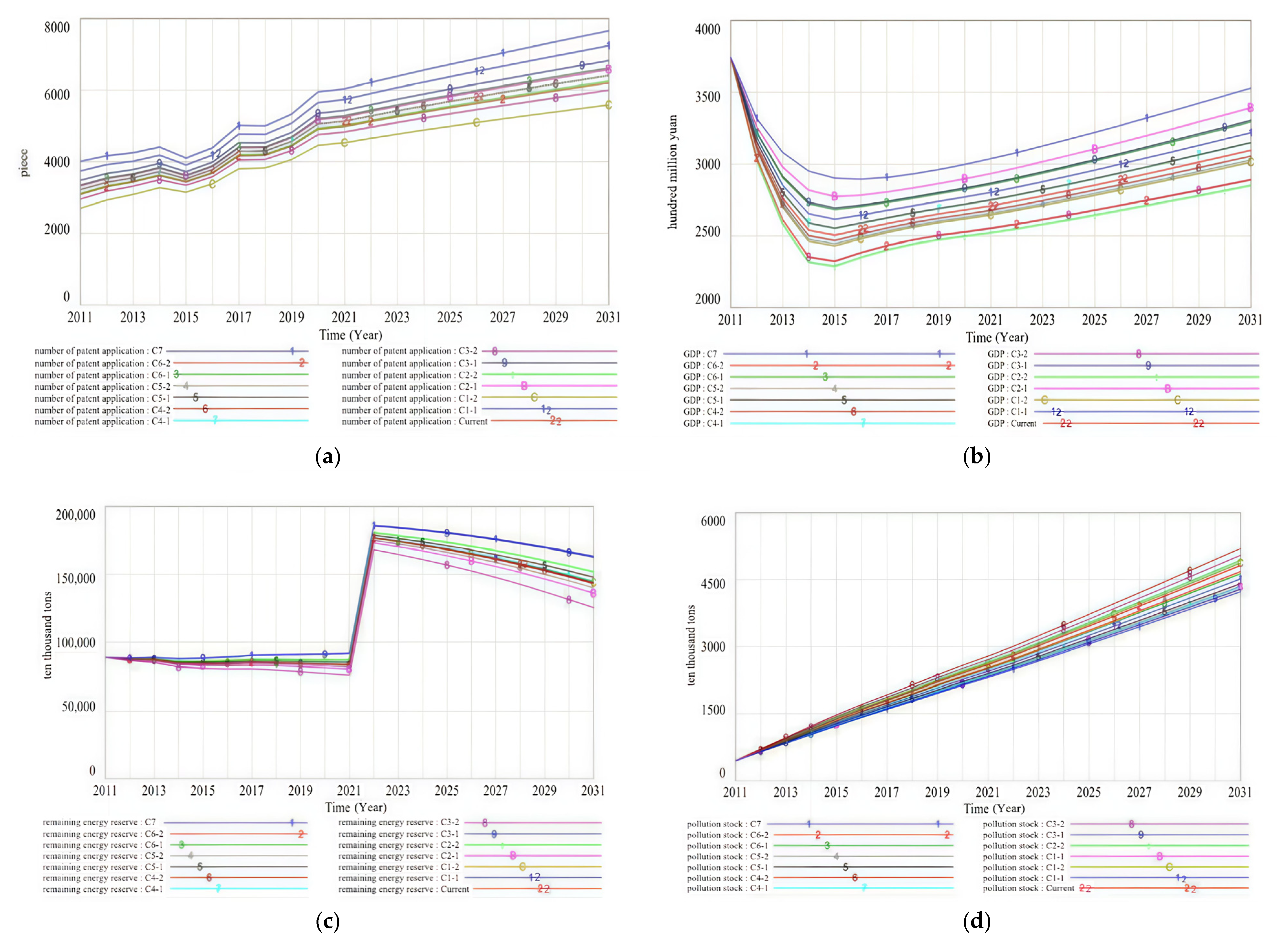
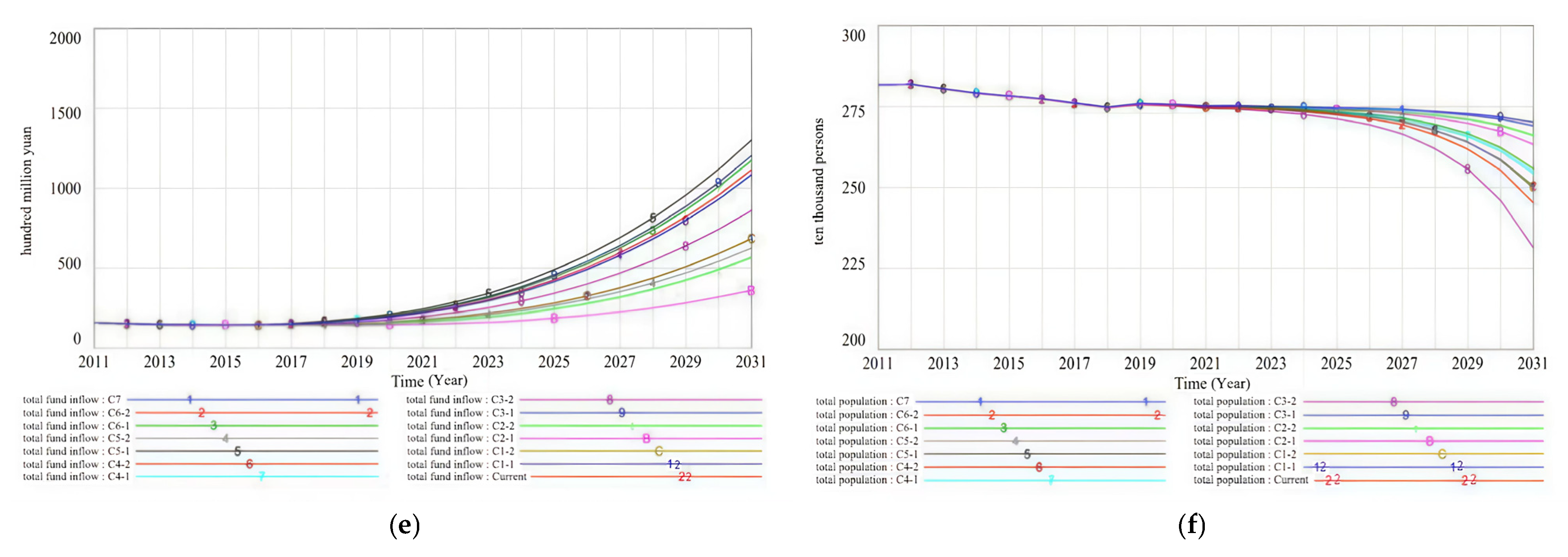
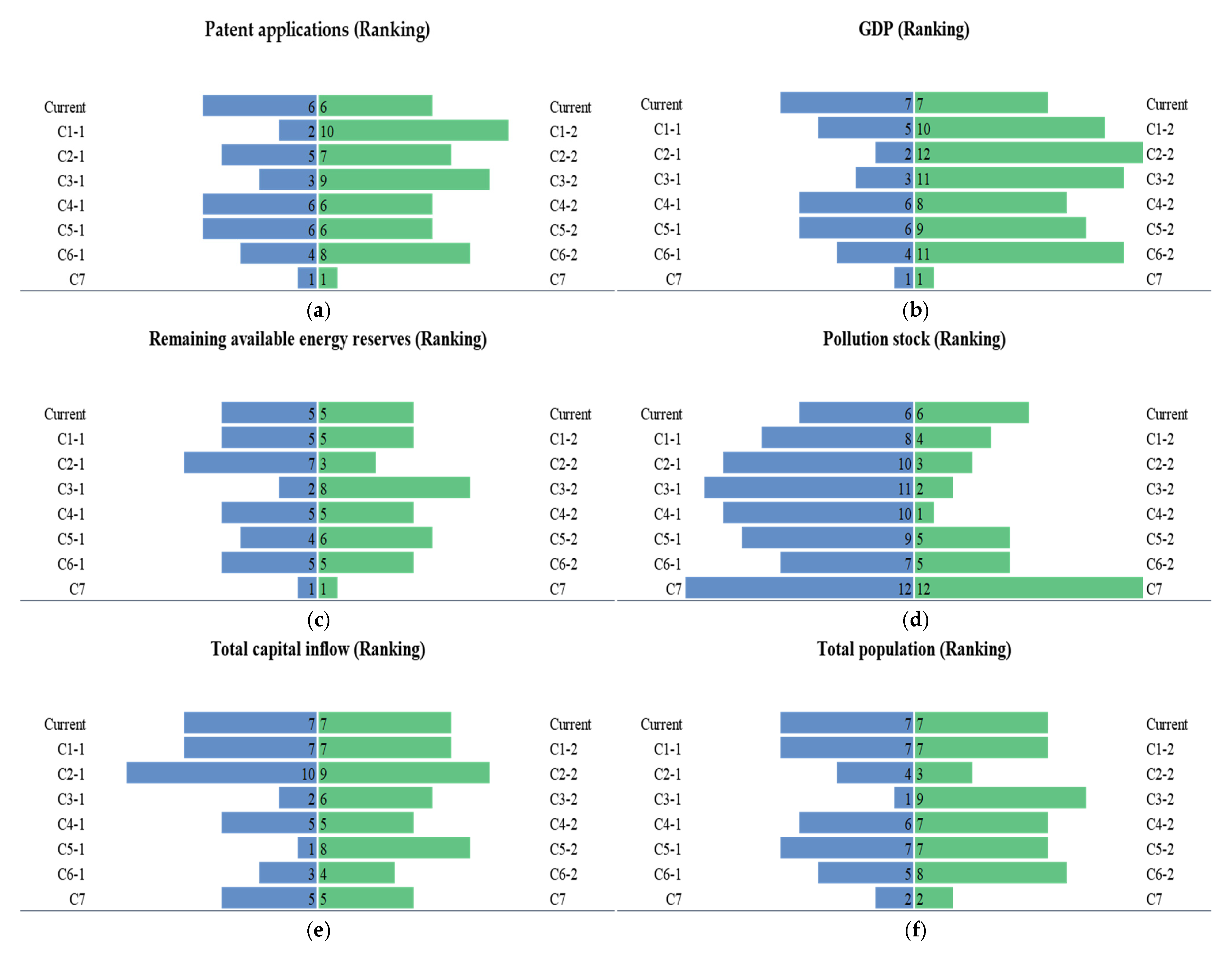
| Input Variable | Output Variable | Effects |
|---|---|---|
| Smart technology investment | Patent applications | Innovative development; Economic growth; Livable environment; Common prosperity; |
| Industrial investment | GDP growth rate | |
| Smart energy construction | Remaining available energy reserves | |
| Pollution control investment | Pollution stock | |
| Smart business environment construction | Total capital inflow | |
| Livelihood construction | Total population |
| Indicator | Calculation Method | Initial Parameter |
|---|---|---|
| Science and technology resource investment coefficient | =R&D expenditure/GDP (including the regional government and enterprise R&D investments in science and technology) | 23.81% |
| Industrial investment structure | =investment in the primary, secondary, and tertiary industries/the total fixed asset investment | 7.53%; 57.88%; 34.59%; |
| Smart energy investment coefficient | =smart energy investment/investment of the secondary industry | 23.91% |
| Smart environmental protection investment coefficient | =environmental pollution control investment/fiscal expenditure | 23.45% |
| Smart business environment construction coefficient | =smart governance investment/fiscal expenditure | 12.00% |
| Smart livelihood construction coefficient | =smart city investment/fixed asset investment | 23.91% |
| Policy Scenario | Science and Technology Resource Investment Coefficient | Industrial Investment Structure | Smart Energy Investment Coefficient | Smart Environmental Protection Investment Coefficient | Smart Business Environment Construction Coefficient | Smart Livelihood Construction Coefficient |
|---|---|---|---|---|---|---|
| Current | 0.2381 | 0.0753:0.5788:0.3459 | 0.2391 | 0.2345 | 0.1200 | 0.2391 |
| C1-1 (+20%) | 0.2857 | |||||
| C1-2 (−20%) | 0.1905 | |||||
| C2-1 (+20%) | 0.0753:0.4630:0.4617 | |||||
| C2-2 (−20%) | 0.0753:0.6946:0.2301 | |||||
| C3-1 (+20%) | 0.2869 | |||||
| C3-2 (−20%) | 0.1913 | |||||
| C4-1 (+20%) | 0.2814 | |||||
| C4-2 (−20%) | 0.1876 | |||||
| C5-1 (+20%) | 0.1440 | |||||
| C5-2 (−20%) | 0.0960 | |||||
| C6-1 (+20%) | 0.2869 | |||||
| C6-2 (−20%) | 0.1913 | |||||
| C7 (+20%) | 0.2857 | 0.0753:0.4630:0.4617 | 0.2869 | 0.2814 | 0.1440 | 0.2869 |
Disclaimer/Publisher’s Note: The statements, opinions and data contained in all publications are solely those of the individual author(s) and contributor(s) and not of MDPI and/or the editor(s). MDPI and/or the editor(s) disclaim responsibility for any injury to people or property resulting from any ideas, methods, instructions or products referred to in the content. |
© 2025 by the authors. Licensee MDPI, Basel, Switzerland. This article is an open access article distributed under the terms and conditions of the Creative Commons Attribution (CC BY) license (https://creativecommons.org/licenses/by/4.0/).
Share and Cite
Cui, L.; Peng, M.; Zhang, H.; Cui, L. Analysis of the Dynamic System Driving High-Quality Transformation of Resource-Based Regions Through Smart Eco-Innovation: Evidence from Daqing City, China. Sustainability 2025, 17, 3153. https://doi.org/10.3390/su17073153
Cui L, Peng M, Zhang H, Cui L. Analysis of the Dynamic System Driving High-Quality Transformation of Resource-Based Regions Through Smart Eco-Innovation: Evidence from Daqing City, China. Sustainability. 2025; 17(7):3153. https://doi.org/10.3390/su17073153
Chicago/Turabian StyleCui, Liying, Min Peng, Hengshuo Zhang, and Liwei Cui. 2025. "Analysis of the Dynamic System Driving High-Quality Transformation of Resource-Based Regions Through Smart Eco-Innovation: Evidence from Daqing City, China" Sustainability 17, no. 7: 3153. https://doi.org/10.3390/su17073153
APA StyleCui, L., Peng, M., Zhang, H., & Cui, L. (2025). Analysis of the Dynamic System Driving High-Quality Transformation of Resource-Based Regions Through Smart Eco-Innovation: Evidence from Daqing City, China. Sustainability, 17(7), 3153. https://doi.org/10.3390/su17073153







